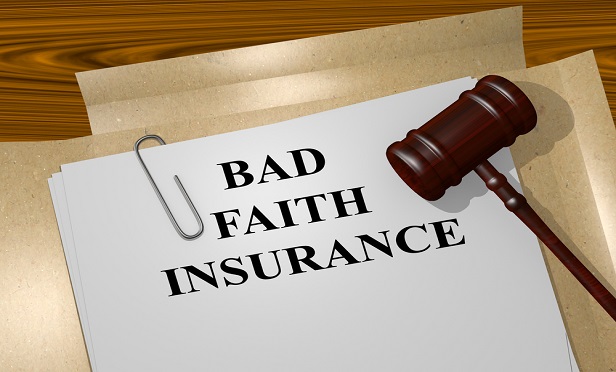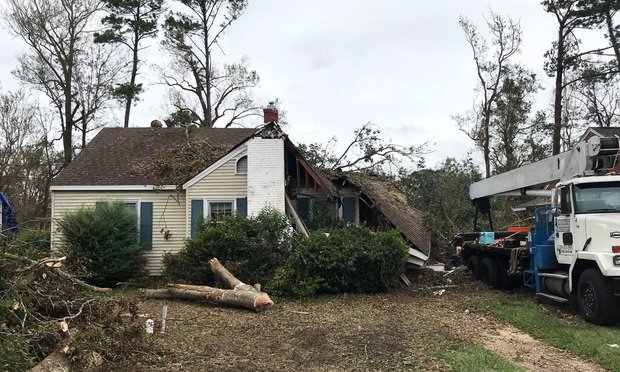This story is reprinted with permissionfrom FC&S Legal, the industry'sonly comprehensive digital resource designed for insurancecoverage law professionals. Visit the website to subscribe.
|Policyholders expect prompt resolution of their claims by theirinsurance companies. When the claim is in dispute, the policyholdermay believe that the company is acting in bad faith and file alawsuit. Generally, policyholders have to follow specificprocedures and may have to wait until appraisers or adjusters havecompleted their work before heading to court. But Florida insuredsmay no longer have to delay, according to a recent state appellatecourt case.
|Proper sinkhole repairs
In 2009, Phillip Landers' home sustained a loss from suspectedsinkhole activity. He submitted a claim to his insurer, State FarmFlorida Insurance Company. State Farm hired SDII Global Corporationto conduct a subsidence investigation. SDII verified that sinkholeactivity was the cause of the damage, and State Farm admittedcoverage.
|SDll initially concluded that 975 cubic yards of grout needed tobe injected into 49 holes around the home's perimeter. SDII did notrecommend underpinning. After considering the report of a neutralevaluator from the Florida Department of Financial Services asrequired by state law, SDII amended its report to require anadditional 15 grout injection points. The cost of this remediationwas estimated at approximately $350,000.
|Landers obtained an independent opinion from Biller ReinhartStructural Group. In Reinhart's opinion, proper stabilizationrequired underpinning. Reinhart's cost of remediation was close to$1 million.
|State Farm provided Reinhart's report for review by the neutralevaluator. The neutral evaluator concluded that underpinning wasunwarranted.
|Related: Must appraisers be objective ordisinterested?
|State Farm demanded appraisal under the policy to resolve theparties' disagreement over the amount of the loss. Landers agreed,pursuant to the terms of the State Farm policy, to proceed withSDll's recommended repair plan, despite his belief that the repairswere inadequate. State Farm placed its appraisal demand on holdwhile the stabilization repairs were made. After the repairs werecompleted in September 2011, State Farm requested appraisal of thecosmetic damage to the home.
|Landers said that his home continued to experience damage afterrepairs were completed, and he hired Sonny Gulati, a geotechnicalengineer, to examine the property. In January 2012, while Gulati'sreport was pending, Landers filed a civil remedy notice (CRN),alleging, among other things, claim delay, failure to promptly andproperly investigate the claim, failure to adjust the loss andfailure to tender policy limits.
|Landers contended that although the repairs had been completedpursuant to State Farm's expert's recommendation, his home remainedunlivable. He demanded the immediate tender of “the policy limitsfor dwelling … of $1,026,500.00 minus any prior payments that havebeen made to the insured … so that [Landers] may adequatelycomplete the repairs [he] has started to [his] home.”
|In response, State Farm requested that all issues be submittedto appraisal.
|Related: 11th Circuit: Florida's bad faith insurance claimshave 5-year statute of limitations
||Mandatory appraisal?
In March 2012, Landers sued State Farm for breach of contract.In that suit, State Farm sought to compel appraisal, which Landersopposed. The trial court did compel appraisal, Landers appealed,and on Jan. 21, 2014, an appellate court affirmed.
|In July 2014, the appraisal panel determined that the amount ofloss exceeded the policy limits. State Farm tendered the policylimits in August 2014, without any deduction for the amountspreviously paid.
|Landers then brought a first-party bad-faith suit against StateFarm, alleging 10 purported violations of Florida state law,including allegations of claim delay and low-balling. Landerscontended that his damages always exceeded the policy limits andthat State Farm had acted in bad faith by delaying payment of thepolicy limits until after appraisal.
|Related: State Farm can't get out of stacking-relatedbad-faith claim
|State Farm moved for summary judgment, asserting that whenLanders filed the CRN, “there was no contractual amount due and nodamages owed under the contract” because a condition precedent topayment — determining the amount of loss through appraisal — hadnot been fulfilled. Therefore, State Farm contended, the CRN wasvoid because Landers' claim was not yet ripe.
|The trial court granted summary judgment in favor of State Farm,and Landers appealed.
|The State Farm policy stated:
|If you and we fail to agree on theamount of loss, either one can demand that the amount of the lossbe set by appraisal. If either makes a written demand forappraisal, each shall select a competent, disinterested appraiser.Each shall notify the other of the appraiser's identity within 20days of receipt of the written demand. The two appraisers shallthen select a competent, impartial umpire. … The appraisers shallthen set the amount of the loss. If the appraisers fail to agreewithin a reasonable time, they shall submit their differences tothe umpire. Written agreement signed by any two of these threeshall set the amount of the loss.
|Related: Making additional repairs without insurer's OK maynot be covered
|The appellate court's decision
The Florida appellate court reversed, holding that an insurer'sdemand for appraisal did not delay the time for filing a CRN untilthe amount of the appraisal was established. In its decision, theappellate court explained the three prerequisites to filing astatutory bad-faith claim:
- Determination of the insurer's liability for coverage;
- Determination of the extent of the insured's damages; and
- The filing of a CRN notice.
The appellate court ruled that the settlement of a sinkholeclaim via the appraisal process was sufficient to satisfy the firsttwo requirements.
|The CRN, the appellate court observed, provided Florida'sDepartment of Financial Services and the insurer 60 days' writtennotice of the claim. During that period, the insurer had anopportunity to cure the alleged violation, and no suit could bebrought if, within those 60 days, the damages were paid or thecircumstances giving rise to the violation were corrected.
|Related: Appeals court resurrects $5M bad faith lawsuitagainst insurance company
|The appellate court then rejected State Farm's argument that aCRN was not effective until all of the contractual preconditions tosuit were met and there was a final determination of coverage andthe amount owed.
||No final determination required
According to the appellate court, the “plain language” of theFlorida law provided “no time limitation for when a CRN may befiled” and did “not require a final determination of coverage anddamages” before it was filed.
|The appellate court reasoned that the purpose of a CRN was “tofacilitate and encourage good-faith efforts to timely settle claimsbefore litigation, not to vindicate continuing efforts to delay.”Filing a CRN before the appraisal process was complete and damageswere determined did not render the CRN a legal nullity, precludingLanders' bad-faith claim, the appellate court ruled.
|The appellate court declared that preventing an insured fromfiling a CRN before coverage and liability had been conclusivelyestablished “would frustrate the purpose of the statute by furtherdelaying the time necessary to assess and pay out claims anddiscouraging insurers from taking timely, independent action onclaims.” Accordingly, it ruled, the fact that the appraisal processwas ongoing did not render a CRN filed during that process a legalnullity. Once the appraisal process was complete, and a legallysufficient CRN had previously been provided, the conditionsprecedent to filing a statutory bad-faith claim were met.
|The appellate court noted that Landers had filed his CRN beforethe appraisal process was complete, State Farm did not cure thealleged violation within the 60-day statutory window, and Landers'position was that had State Farm properly investigated his claim,it would have known that the subsurface repair plan was inadequate.Whether State Farm had actually acted in bad faith in resolvingLanders' claim presented a question of fact that remained to beresolved, the appellate court said, but nothing in the statute orcase law precluded the filing of a CRN while a demand for appraisalwas outstanding, it concluded.
|The case is Landers v. State Farm Florida Ins. Co.
|Related: 9th Circuit reduces $2.5M bad faith award againstGEICO to $1M
|Steven A. Meyerowitz, Esq., is thedirector of FC&S Legal, the editor-in-chief of the InsuranceCoverage Law Report, and the founder and president of MeyerowitzCommunications Inc. Email him at [email protected].
Want to continue reading?
Become a Free PropertyCasualty360 Digital Reader
Your access to unlimited PropertyCasualty360 content isn’t changing.
Once you are an ALM digital member, you’ll receive:
- All PropertyCasualty360.com news coverage, best practices, and in-depth analysis.
- Educational webcasts, resources from industry leaders, and informative newsletters.
- Other award-winning websites including BenefitsPRO.com and ThinkAdvisor.com.
Already have an account? Sign In







